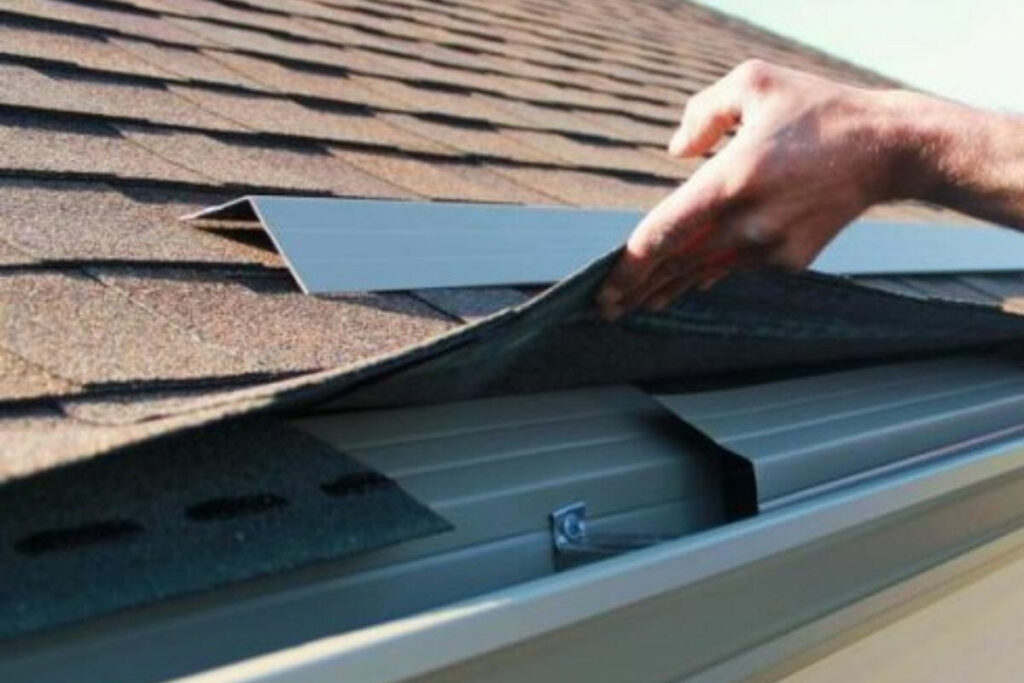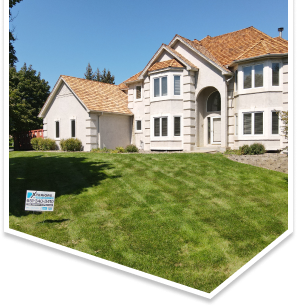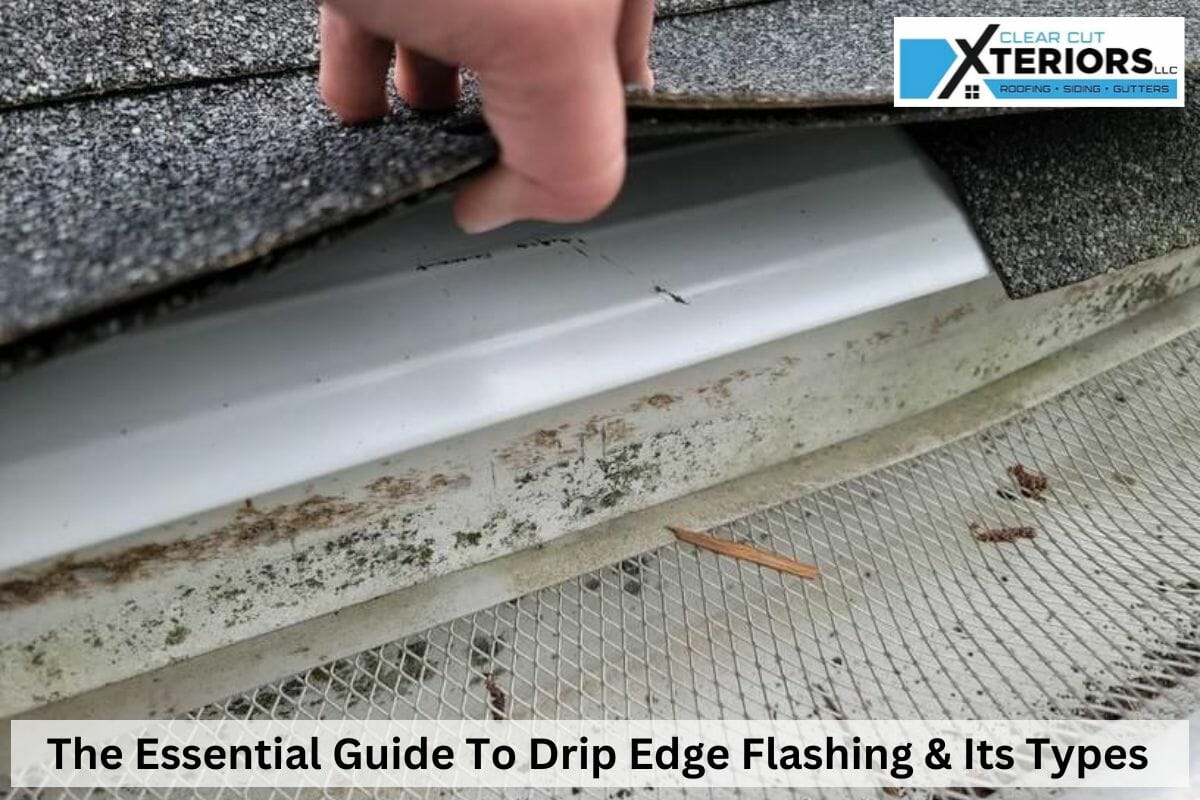While the drip edge isn’t a visible and obvious component of your roof, it is an essential part that works discreetly to protect your roof.
Installed along the roof’s edge, overlapping the roof underlayment, drip edge flashing acts as a bridge that allows water to flow directly into your gutters. It stops rain from infiltrating the roofing material, prevents ice dams on the roof, and protects the eaves from damage. In this blog post, we will go over the importance of drip edge flashing and its types.
What Is Drip Edge Flashing?
A drip edge is a roofing component installed along the roof’s eave, over the fascia to effectively manage the water flow from the roof into the gutters. Made of different materials and available in numerous shapes, drip edge flashing serves many purposes. It extends beyond the roof’s fascia to stop water from flowing behind the siding and eaves.
Like many other types of flashing installed on your roof, drip edge flashing directs water into the gutters, stopping it from entering the roof deck and consequently causing damage. As it can increase the lifespan of your roof by stopping water damage, installing drip edge flashing along the roof’s eaves and gable ends is necessary during your roof installation.
Want to know more about drip edges? Read our blog post: Drip Edge 101: The Ultimate Guide To Protecting Your Roof And Foundation
Types of Drip Edge Flashing

1. L-Shaped Drip Edge Flashing
The L-shaped drip edge is the most traditional and widely used type. It forms an L-shape when viewed in cross-section, with one leg extending over the roof deck and the other down the fascia. This design effectively diverts water away from the edge.
2. T-Shaped Drip Edge Flashing
A T-shaped drip edge resembles the letter T. This type of drip edge is similar to the L-shaped but features an additional horizontal leg that extends over the roof deck. This added feature provides extra protection against water intrusion and ice dams.
3. J-Shaped Drip Edge Flashing
J-shaped drip edges have a profile that resembles the letter J. They offer excellent protection against wind-driven rain and are commonly used in areas prone to severe weather.
4. C-Shaped Drip Edge Flashing
C-shaped drip edge flashing is another common variation used on roofing systems. It’s named for its distinctive C-shape. This design makes it highly effective at channeling water away from the roof edge.
Why Installing A Drip Edge On Your Roof Is Important
1. A Drip Edge Safeguards The Fascia
Many homeowners are unaware of it, but the fascia is a board that runs along the eaves of your home where your gutters are installed. The fascia is an integral part of a roofing system that keeps water and moisture from entering the roof deck and rafters.
While the fascia is made of strong materials, such as wood, aluminum, and fiber cement, water can still seep into the roofing system through small gaps and holes. This is why drip edge flashing is installed on top. Extending beyond the fascia, the drip edge directs the water effectively into the gutter system.
2. Closes The Carpenter Gaps
Carpenter, or builder’s gaps, are the space between the roof deck and fascia. Sometimes they are left intentionally to increase the amount of ventilation. Despite the many reasons they are left open, the carpenter’s gap is a gateway for pests to enter your home. They can slip into your home through these gaps and eat away at roofing materials, which is why filling these gaps is important. Drip edge flashing seals the gaps and stops pests from entering your home.
3. Prevent Ice Dams On the Roof
There are many reasons why ice dams would form along your roof’s edge. First, snow on your roof melts as the heat escapes from your ridge vent. This melted snow refreezes along the roof’s edge, as that part of the roof is much colder. This ice then sits at the edge of your roof, growing in size as more water melts and refreezes, adding a significant amount of weight to the roof. This added weight on your roof’s edge can potentially damage your roof and become a cause of roof sagging.
Ice dams aren’t just a problem for your roof’s edge, it can potentially damage your gutters and lead to major repairs. The drip edge seamlessly allows water to flow rather than cling to the roof’s edge. This can increase the lifespan of your roofing system and prevent costly damage caused by excess weight.
What Is Drip Edge Overlap?
Another essential term associated with the drip edge is overlap. If you have been wondering if you should overlap the drip edge on your home, you’re not alone.
Drip edge overlap refers to the extent to which one section of a drip edge overlaps another section when they are installed on a roof. When installing a drip edge on a roof, ensure that one section of the drip edge overlaps the adjacent section, like the fascia, correctly. This overlap helps to create a continuous barrier that directs water away from the roof and into the gutter system. This helps prevent water infiltration and potential damage to the roof’s structural integrity.
The amount of overlap required can vary depending on local building codes, the manufacturer’s recommendations, and the type of roofing material used. A recommended overlap of 1 to 2 inches is common.
Also Read: A 2-Minute Guide To Perfecting Drip Edge Overlap & Avoiding Costly Mistakes
The Benefits Of Proper Drip Edge Overlap
Enhanced Water Diversion: When drip edges overlap correctly, they create a seamless barrier against water infiltration. This ensures that water will flow into the gutters directly, reducing the risk of leaks and damage.
Preventing Wind Uplift: Adequate overlap prevents wind from getting underneath the drip edge, which could lead to uplift and damage during storms.
Longevity: Properly overlapped drip edges last longer, protecting your roof and fascia for years to come.
Final Thoughts
Drip edge flashing may not be the star of the show, but it’s undoubtedly an essential part of the roofing system. By understanding its purpose, choosing the right type and material, and maintaining it properly, you can protect your home from water damage and enhance its curb appeal.
A Trusted And Reliable Roofing Contractor In Minneapolis, MN
Do you see signs of damage on your roof? Water dripping, mold growth, missing shingles, dented flashings, and displaced drip edges are all signs of roof damage. If your roof needs repair or replacement in Minneapolis, MN, contact Clear Cut Xteriors at (651) 340-3410. Our team of professional roofers have years of experience installing and maintaining many types of roofs, including asphalt shingle, metal, and flat roofs. Call us today to schedule your free consultation!



